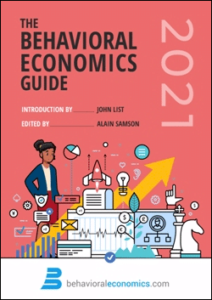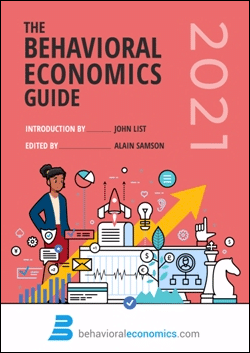
The zero price effect suggests that traditional cost-benefits [sic] models cannot account for the psychological effect of getting something for free. A linear model assumes that changes in cost are the same at all price levels and benefits stay the same. As a result, a decrease in price will make a good equally more or less attractive at all price points. The zero price model, on the other hand, suggests that there will be an increase in a good’s intrinsic value when the price is reduced to zero (Shampanier et al., 2007). Free goods have extra pulling power, as a reduction in price from $1 to zero is more powerful than a reduction from $2 to $1.
This is a quote from page 194 of The Behavioral Economics Guide, 2021, available on line at a zero price.
The authors state this point as if they think that the point they are addressing is a puzzle, or somehow doesn’t follow from, basic economics. But it does.
Put aside the fact, which the authors should know, that there’s no such thing as “intrinsic value.” Value is subjective.
The problem is even more basic. Drop the price from $2 to $1 and let people buy as much as they want, and they buy a given amount, which we can be reasonably sure is greater at $1 and than at $2. But drop the price from $1 to $0 and people can buy unlimited amounts. In fact, we shouldn’t even use the word “buy.” They won’t pay. So it shouldn’t be surprising that people will often value a price cut from $1 to $0 way more than they value a price cut from $2 to $1. The gain in consumer surplus is greater with the price cut from $1 to $0 than with the price cut from $2 to $1.
HT2 Timothy Taylor, aka The Conversable Economist.


READER COMMENTS
Mark Z
Jul 20 2021 at 8:35pm
Wouldn’t an apparent zero price effect only requires a ‘psychological’ explanation if the consumer appears to reach the point of negative marginal utility (and the demand curve flattens) before price reaches 0, but then jumped up at 0? Otherwise, demand should jump to the point on the y-axis where marginal utility of consumption is 0.
And isn’t it generally understood that real demand curves tend to be concave upwards, not linear? Maybe for precisely this reason. So of course demand accelerates as prices decline toward 0. So yeah, as you say, an apparent zero price effect doesn’t necessarily require an explanation.
Airman Spry Shark
Jul 20 2021 at 9:49pm
A drop from $2 to $1 is a 50% reduction; from $1 to $0 is an infinity% decrease. Expecting similar responses to the two changes is absurd.
David Henderson
Jul 20 2021 at 10:01pm
Actually, a drop from $1 to $0 is a 100% reduction. But percentages are not the way to look at it anyway.
Frank
Jul 20 2021 at 10:28pm
Free? Sure, I’ll use platinum foil instead of aluminum foil to wrap my leftovers, and lots of it! “Free goods have extra pulling power” is a completely useless statement, as it assumes away scarcity. It’s not even wrong. 🙂
Don Boudreaux
Jul 21 2021 at 6:56am
Frank nails it. Any price above zero implies that the good is scarce; a price of zero implies that the good isn’t scarce. And non-scarce goods differ from scarce goods categorically; less-(but-still-)scarce goods do not differ from more-scarce goods categorically.
Suppose that on Wednesday breathable air on earth’s surface suddenly and unexpectedly becomes mildly scarce, fetching a price on Wednesday of $0.03 per gallon. Imagine the subjectively experienced loss of utility the typical person would experience upon awakening on Wednesday – likely from the act of gasping for air! – to discover that air is no longer superabundant. I do not go far out on a limb to predict that this utility loss would be enormous.
Now suppose that on Thursday air becomes even more scarce, such that its price doubles to $0.06 per gallon. The result: On Thursday people experience yet another more loss of utility, to be added to the loss they experienced on Wednesday. But surely the reduction in utility from Wednesday to Thursday is nothing like the reduction in utility from Tuesday to Wednesday. The reduction in utility from Tuesday to Wednesday is much greater – implying, of course, that the gain in utility in going from air priced at $0.03 per gallon to $0 would be much greater than would be the gain in utility in going from air priced at $0.06 to $0.03 – or even from $0.03 to $0.0001.
Rob Rawings
Jul 20 2021 at 11:18pm
Is there an element of reasoning from a price change here?
One reason that the price of a good may drop to zero is that people gain less utility from it than previously (perhaps its been proved hazardous to health). A drop from $1 to $0 may coincide with a fall in consumer surplus.
David Henderson
Jul 21 2021 at 11:43am
Yes, it is reasoning from a price change. In this case that seems legitimate, though, because it is pretty clear from context that the demand curve didn’t shift but the supply curve shifted dramatically to the right.
J Mann
Jul 21 2021 at 11:20am
Is there such a thing as a zero cost good? I’d normally assume opportunity costs mean that even perceived zero cost goods have costs that limit consumption.
Make rice free and I’ll consume more of it, but I won’t consume an infinite amount. Eating it means I can’t eat something else, and I would need to store any stockpiled rice, and probably transport it, and prevent it from attracting pests to my house, so at some point, I would have too much rice.
Given that even free goods have opportunity cost, is there a possibility that there is some behavioral effect that causes people to value “free” goods more that standard economics would predict? My guess is no, but I’d need to know more about the research.
(To link back to Scott’s discussion of measuring inflation, my experience is that there is more supply of tube TVs than demand at a price of $0 – the issue is that people with the TVs want someone to take away their TV, and it’s not worth the transport to have one.)
AMT
Jul 21 2021 at 7:17pm
(emphasis added)
But why would you assume people may “buy” as much as they want? This theory is relevant for analyzing situations where a seller is offering incentives to draw in customers (E.g. Does demand change if a burger joint offers buy one get one free, versus buy one get one for 1 penny?); they obviously aren’t in the business of giving away an infinite amount of any product or service for free. For that reason, the cited study by Shampanier, Mazar and Ariely didn’t consider an offering of an infinite supply, nor would anyone consider attempting such a study. It’s beside the point and irrelevant because it would never happen.
So your conclusion,
is incorrect because quantity restrictions are obviously implicit.
Jon Murphy
Jul 22 2021 at 7:48am
It’s a demand question, not a supply question. We’re not talking equilibrium here; we’re talking movement along the demand curve and how demanders value the marginal good.
In other words, the point about quantity supplied is irrelevant.
Jon Murphy
Jul 22 2021 at 9:20am
This is an important aside:
To “buy as much as they want” does not imply a quantity demanded of infinity. The demand curve still intersects the zero-price axis at some point less than infinity for two main reasons:
First: the Law of Diminishing Returns. The Law of Diminishing Returns tells us that each marginal unit an individual consumes, their marginal gain from it is generally less than the previous unit. At some point, that marginal gain is 0, or even negative. And that point will be fair before one hits infinity. So, even if ice cream (which I love) were zero-price, I would not consume infinite quantities of ice cream because at some point, my marginal gains from the ice cream will be zero (or even negative! I could get a tummy ache and get sick).
Second: Exchange is inherently limited by the extent of the market. Suppliers can only supply to the amount consumers are willing to buy, and that is inherently limited by the number of consumers in the market.
In other words, the only way a zero price would mean that firms must supply an infinite amount of the good would be if there are infinite consumers or a constant return to consumption.
AMT
Jul 22 2021 at 1:21pm
I agree the point is about the marginal change in demand, which is why I was criticizing David saying, “But drop the price from $1 to $0 and people can buy unlimited amounts.” See, uh, my comment… e.g. …”(E.g. Does demand change if a burger joint offers buy one get one free, versus buy one get one for 1 penny?)” (And to clarify, e.g. $5.99 plus 1 penny vs $6.00 for buy one get one free.)
Just as I never accused David of saying people would actually take literally an unlimited amount of free product even if it was theoretically available, because he never said that, I never said that. Please read more carefully and stop accusing me of mistakes by putting words in my mouth. That is your mistake. It’s also ironic, given my main criticism is arguing that quantities are certainly limited. Also, we are all well aware that there are not literally infinite supplies available.
https://www.dictionary.com/browse/unlimited
If you believe my word choice was a critical error, change it to unlimited, the word David used.
Jon Murphy
Jul 22 2021 at 1:40pm
I think you’re still doing an unintentional bait and switch with the word “infinity” here. I agree David perhaps could have been a bit more precise, but he did not use the word “infinite” so swapping it in, and thus changing the meaning, is a mistake on your part.
Mark Z
Jul 22 2021 at 8:37pm
I don’t see why supply being finite makes it any more surprising for demand to decline more from the price going from 0 to 1 than 1 to 2. Quantity doesn’t half to be infinite for David’s point. It just has to be higher than what demand would be at price = 0 if the demand curve were linear.
Jerry Brown
Jul 22 2021 at 1:00am
Why would there not be some ‘intrinsic value’ for some things? At least as far as people are concerned?
I mean there are some things that all people need to live- Don Boudreaux talks about air in his comment. Air is something we can’t live without for even a few minutes. It has a large intrinsic value to me even if I don’t generally need to pay to breathe. Food and water would also seem to have intrinsic value whereas a work of art might not?
Jon Murphy
Jul 22 2021 at 7:50am
Intrinsic value means that the value is objective and located within the thing. That good X is valuable does not imply it has intrinsic value. It’s the ol’ water-diamonds paradox. It depends on what margin we’re looking at.
For example, a scuba-diver has a much higher value for air than a person on the surface for the same breath of air. Thus, the value of the air is subjective, not intrinsic.
Jerry Brown
Jul 22 2021 at 1:32pm
Thanks Jon. I guess I just am not understanding the usage of the word intrinsic here. Happens sometimes unfortunately…
Comments are closed.